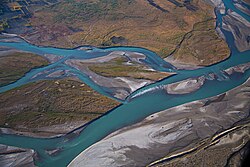
Back نهر كابل Arabic نهر كابل ARZ دریای کابل چایی AZB Кабул (рака) Byelorussian Кабул (река) Bulgarian কাবুল নদী Bengali/Bangla Riu Kabul Catalan Kābul River CEB Kábul (řeka) Czech Кабул (юханшыв) CV
| Kabul River | |
|---|---|
 Aerial photo of Kabul River flood-plain east of Kabul, Afghanistan | |
| Etymology | Kabul's River in Dari/Persian |
| Native name | Daryā-ye Kābol (Pashto) |
| Location | |
| Countries | Afghanistan and Pakistan |
| Cities | Kabul, Surobi, Jalalabad (Afghanistan); Peshawar, Charsadda, Nowshera (Pakistan) |
| Physical characteristics | |
| Source | Hindu Kush Mountains |
| • location | Near Maidan Shar, Maidan Wardak, Afghanistan |
| • coordinates | 34°21′25″N 68°50′21″E / 34.357°N 68.8392°E |
| • elevation | 2,400 m (7,900 ft) |
| Mouth | Indus River |
• location | Near Kund Park, Attock, Punjab, Pakistan |
• coordinates | 33°55′0″N 72°13′56″E / 33.91667°N 72.23222°E |
| Length | 700 km (430 mi) |
| Basin size | 70,500 km2 (27,200 sq mi) |
| Basin features | |
| Tributaries | |
| • left | Panjshir River, Alingar River, Kunar River, Swat River |
| • right | Logar River, Surkhab River, Bara River |
The Kabul River (Urdu: دریائے کابل; Dari: دریای کابل; Pashto: د کابل سیند), the classical Cophen /ˈkoʊfeɪn/, is a 700-kilometre-long (430 mi) river that emerges in the Sanglakh Range of the Hindu Kush mountains in the northeastern part of Maidan Wardak Province, Afghanistan. It is separated from the watershed of the Helmand River by the Unai Pass. The Kabul River empties into the Indus River near Attock, Pakistan. It is the main river in eastern Afghanistan and the Khyber Pakhtunkhwa province of Pakistan.
